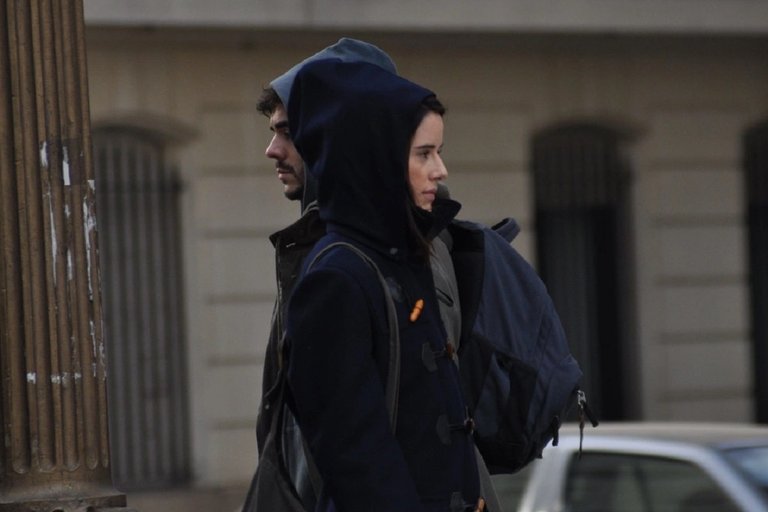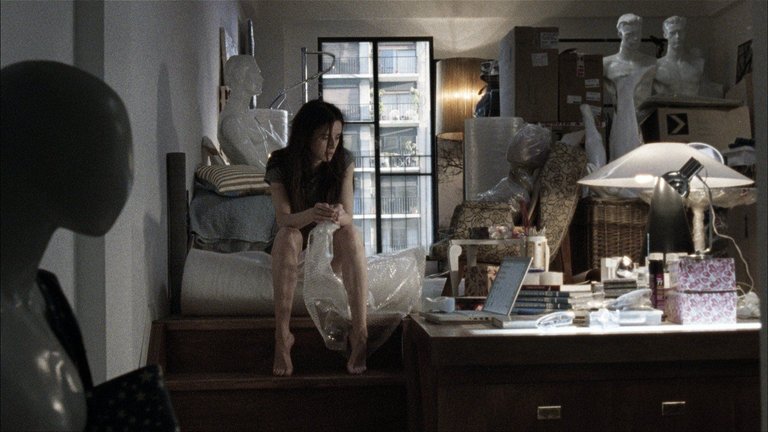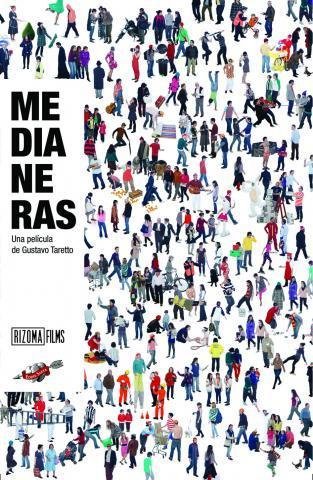Medianeras (2011): solitudes that orbit each other | soledades que se orbitan

Una película romántica, divertida y muy reflexiva
I've always thought that Argentine cinema is the best in South America. Of course, very good films have also been made in Brazil, Chile, Colombia and Venezuela. From Peru I only remember one adaptation that I saw of a novel by Mario Vargas Llosa and I have not seen anything from Uruguayan, Paraguayan, Ecuadorian or Bolivian cinema, beyond some joint productions. But it seems to me that there are more good films that come out of Argentine soil than from any other of its neighboring countries.
Siempre he pensado que el cine argentino es el mejor de américa del sur. Claro que también se han hecho muy buenas películas en Brasil, Chile, Colombia y Venezuela. De Perú sólo recuerdo una adaptación que vi de una novela de Mario Vargas Llosa y de cine uruguayo, paraguayo, ecuatoriano o boliviano no he visto nada, más allá de algunas producciones conjuntas. Pero me parece que son más las buenas películas que salen de suelo argentino que de cualquier otro de sus países vecinos.
Perhaps it's that a greater number of films are produced there in general and due to a volume issue they end up having more outstanding works, or perhaps it has to do with its rich literary heritage, I don't know, but I don't remember having seen an Argentine film that seemed to me bad (not even The Night of the Pencils, with its modest budget and filmed so many years ago, can be considered a bad movie). Some of my favorites (all with Ricardo Darín) are The Secret in Their Eyes, the iconic Wild Tales and the most recent Argentina: 1985. For this reason, I welcome the possibility of watching an Argentine film even if I don't know anything about the story, or its actors or creators. Let's say that there is a certain type of anticipated trust (yes, you can also call it prejudice) and thanks to that trust I dared to see Medianeras (Sidewalls), written and directed by Gustavo Taretto and starring Pilar López de Ayal and Javier Drolas. When I came across this film on MUBI, I only knew that it was Argentine, that the platform recommended it and that the story was about two people who cross paths without meeting each other. That was it. I don't even remember having heard of it before in any listing, or in any recommendation, and although I know that MUBI's focus is auteur cinema (often non-commercial) I was a little surprised to find this film.
Quizás sea que se producen mayor cantidad de películas en general y por un tema de volumen acaben teniendo más obras destacadas, o quizás tenga que ver con su rica herencia literaria, no lo sé, pero no recuerdo haber visto una película argentina que me haya parecido mala (ni siquiera La noche de los lápices con su modesto presupuesto y filmada hace tantos años, se puede considerar una película mala). Algunas de mis favoritas (todas con Ricardo Darín) son El secreto de sus ojos, la icónica Relatos Salvajes y la más reciente Argentina: 1985. Por eso, miro con buenos ojos la posibilidad de ver una película argentina aunque no sepa nada de la historia, ni de sus actores o creadores. Digamos que hay cierto tipo de confianza anticipada (sí, también lo pueden llamar prejuicio) y gracias a esa confianza me atreví a ver Medianeras, escrita y dirigida por Gustavo Taretto y protagonizada por Pilar López de Ayal y Javier Drolas. Cuando me topé con esta cinta en MUBI sólo sabía que era argentina, que la plataforma la recomendaba y que la historia iba de dos personas que se cruzan sin encontrarse. Eso era todo. Ni siquiera recuerdo haber oído de ella antes en algún listado, o en alguna recomendación, y aunque sé que el foco de MUBI es el cine de autor (muchas veces poco comercial) me sorprendió un poco encontrarme con este film.

The film has three main characters: Mariana, Martín and the city of Buenos Aires. We've seen Woody Allen's celebration of his beloved New York every time he can and we have also seen other stories that are love letters to one or several cities in the world, but somehow the omnipresent Buenos Aires metropolis acts in this story as villainous, because it's its structure, its tons of concrete, its crowded and chaotic nature, never devoid of beauty, that prevents Mariana and Martín from meeting each other despite being neighbors.
La película tiene tres personajes principales: Mariana, Martín y la ciudad de Buenos Aires. Hemos visto la celebración que hace Woody Allen de su amada Nueva York cada vez que puede y también hemos visto otras historias que son cartas de amor a una o varias ciudades en el mundo, pero de alguna manera la onmipresente metrópolis bonaerense actúa en esta historia como villana, porque es su estructura, sus toneladas de hormigón, su naturaleza atiborrada y caótica, nunca exenta de belleza, la que impide que Mariana y Martín se conozcan a pesar de ser vecinos.
That's how it is. They live on the same street, but they don't know each other, they have never seen each other and their routines and rhythms of life prevent them from meeting each other, many times, for the same reasons. Mariana is an architect, but she works designing store windows, a job she does alone and in which she's always accompanied by mannequins (artificial representation of a person). She's afraid of elevators and claustrophobic, she has just ended a four-year relationship with a man who was always a complete stranger to her, and her favorite book of all time is Where's Wally?. For his part, Martín has spent two years locked in his apartment working, playing video games and seeing the world through a screen ("The Internet brought me closer to the world, but it took me away from life"). He's a web designer, quite geek (he collects figurines, has a lightsaber), he doesn't take any means of transportation (he walks everywhere) and seven years ago his girlfriend went on a trip from which she didn't want to return. Mariana is sweet and observant. Martín is tender and has a good sense of humor. Both are solitary beings, somewhat clumsy when relating to others and have a deep desire to love someone. We don't have to go very far in the film for us to start wishing that these two characters would meet because if there are two beings who deserve to love each other, it is the two of them. And yet, they don't know each other. They pass by without seeing each other, they live on opposite sides of the same street, we see them crossing each other just a few centimeters away. But they don't see each other.
Así es. Viven en la misma calle, pero no se conocen, nunca se han visto y sus rutinas y sus ritmos de vida les impiden coincidir, muchas veces, por las mismas razones. Mariana es arquitecto, pero trabaja diseñando vitrinas de tiendas, un trabajo que hace sola y en cuyo ejercicio está acompañada siempre de maniquíes (representación artificial de una persona). Le tiene miedo a los ascensores, es claustrofóbica, acaba de terminar una relación de cuatro años con un hombre que siempre fue un completo desconocido para ella y su libro favorito de toda la vida es ¿Dónde está Wally?. Por su parte, Martín ha pasado dos años encerrado en su departamento trabajando, jugando videojuegos y viendo el mundo a través de una pantalla ("Internet me acercó al mundo, pero me alejó de la vida"). Es diseñador de páginas web, bastante geek (colecciona figurines, tiene un sable de luz), no toma ningún medio de transporte (va caminando a todos lados) y hace siete años que su novia se fue en un viaje del que no quiso regresar. Mariana es dulce y observadora. Martín es tierno y tiene buen sentido del humor. Ambos son seres solitarios, algo torpes al relacionarse con los demás y tienen profundas ganas de amar a alguien. No hace falta avanzar mucho en la película para que comencemos a desear que estos dos personajes se encuentren porque si hay dos seres que merecen amarse mutuamente son ellos dos. Y sin embargo, no se conocen. Se pasan por un lado sin verse, viven en los lados opuestos de una misma calle, los vemos cruzarse a escasos centímetros. Pero no se ven.

Buenos Aires, the beautiful Argentine capital that they both live, unites them without bringing them together. It separates them with its heterogeneous architecture, its infinite wiring, its horrible and worn party walls, but above all, with the internet boom. The film is set at the beginning of this century and although it is a date very close to the present, the world was different, different from ours, but above all from what the world of Martín and Mariana had been until then. Internet, YouTube, sending emails, chatting anonymously, the first dating websites... the way of interacting with the world and with other people went from the organic to the virtual in the blink of an eye and it's in that context in which, without knowing it, the protagonists are looking for each other, but how can you recognize what you are looking for when you find it if you don't know what what you are looking for looks like?
Buenos Aires, la hermosa capital argentina que ambos habitan los une sin reunirlos. Los separa con su arquitectura heterogénea, sus cableados infinitos, sus medianeras horribles y gastadas, pero sobre todo, con el boom del internet. La película está ambientada a principios de este siglo y aunque es una fecha muy cercana a la actual, el mundo era otro, diferente al nuestro, pero sobre todo al que había sido el mundo de Martín y Mariana hasta entonces. Internet, YouTube, enviar correos electrónicos, chatear desde el anonimato, las primeras webs de citas... la forma de relacionarse con el mundo y con las demás personas pasó de lo orgánico a lo virtual en un abrir y cerrar de ojos y es en ese contexto en el que, sin saberlo, los protagonistas se buscan, pero ¿cómo poder reconocer eso que buscas cuando lo encuentres si no sabes cómo se ve lo que estás buscando?
Appealing to objectivity, I must say that I do believe that the film has a defect and it's one that, just barely, fails to destroy the work: there's an excess of voice-overs. I have said before that voiceovers are a resource that I don't like very much, I prefer things to be shown to me rather than verbalized too much, but it can be tolerated to a certain extent. In the case of Madianeras this measure is excessive, especially in the first half. I find interesting the reflections on the culture of the tenant, human relationships, the responsibility of the city in the affections of its inhabitants, all told with humor and accompanied by beautiful shots of urban corners, but the mix of those words with those images, seem to me me closer to poetry or essays than to cinema. I even think I would really enjoy reading all those long paragraphs in a novel, but not hearing them in the characters' voices. I would have preferred other ways to show some things. And yet, as the film progresses, when these internal monologues begin to space out and we begin to see more of Mariana and Martín interact with the world around them, when the windows open to hear True Love Will Find You in the End, when we realize that they are meant for each other, even though they have never met, the film makes us laugh and smile, and that feeling of happy nostalgia for something that has not happened manages to make us forgive the excess of voiceovers and that sociological and architectural study with its infinite images of building facades that the director shows us.
Apelando a la objetividad, debo decir que sí creo que la película tiene un defecto y es uno que, por muy poco, no logra destruir la obra: hay un exceso de voces en off. He dicho anteriormente que las voces en off son un recurso que no me gusta mucho, prefiero que me muestren las cosas antes que me las verbalicen demasiado, pero se puede tolerar en cierta medida. En el caso de Madianeras esa medida es excesiva, sobre todo en la primera mitad. Encuentro interesantes las reflexiones sobre la cultura del inquilino, las relaciones humanas, la responsabilidad de la ciudad en las afecciones de sus habitantes, todo contado con humor y acompañado con tomas hermosas de rincones urbanos, pero la mezcla de esas palabras con esas imágenes, se me hace más cercana a la poesía o al ensayo que al cine. Incluso, creo que disfrutaría mucho leyendo todos esos extensos párrafos en una novela, pero no escuchándolas en las voces de los personajes. Hubiera preferido otras formas de mostrar algunas cosas. Y sin embargo, a medida que avanza la película, cuando estos monólogos internos comienzan a espaciarse y comenzamos a ver más a Mariana y a Martín interactuar con el mundo que los rodea, cuando se abren las ventanas para escuchar True Love Will Find You in the End, cuando nos damos cuenta de que son el uno para el otro, aunque nunca se hayan visto, la película nos hace reír y sonreír, y esa sensación de nostalgia feliz por algo que no ha ocurrido logra hacernos perdonar el exceso de las voces en off y ese estudio sociológico y arquitectónico con su infinidad de imágenes de fachadas de edificios que nos muestra el director.

And that is why I am grateful to the actors and the director, for having given us this story that stays with you after the final scene, for having left me the anecdote of Corina Kavanagh and her skyscraper, for giving me a romantic soundtrack for this week, for show me little ugly corners of the Argentine capital that are beautiful in their own way, for increasing my desire to go and see Buenos Aires, but above all for having created two characters who have become one of my favorites and who I will think about when I look out a window on the eighth floor, when I see people passing by without looking or when I feel like I can't find what I'm looking for because I don't know what to look for, have any of you seen Medianeras? I read you in the comments.
Y por eso estoy agradecido con los actores y con el director, por habernos regalado esta historia que se queda contigo después de la escena final, por haberme dejado la anécdota de Corina Kavanagh y su rascacielos, por regalarme un romántico soundtrack para esta semana, por mostrarme rinconcitos feos de la capital argentina que son bellos a su manera, por aumentarme las ganas de ir a conocer Buenos Aires, pero sobre todo por haber creado a dos personajes que se han convertido en unos de mis favoritos y en los que pensaré cuando me asome a una ventana en un octavo piso, cuando vea a la gente cruzarse sin mirar o cuando sienta que no encuentro lo que estoy buscando porque no sé qué buscar, ¿alguno de ustedes ha visto Medianeras? Los leo en los comentarios.
Reseñado por @cristiancaicedo
Other posts that may interest you | Otros posts que pueden interesarte:
  |
|---|




From Venezuela, our witness drives decentralization and the adoption of Web3 technology, creating opportunities for the local community and contributing to the global ecosystem. // Desde Venezuela, nuestro testigo impulsa la descentralización y la adopción de la tecnología Web3, generando oportunidades para la comunidad local y contribuyendo al ecosistema global.
Sigue, contacta y se parte del testigo en: // Follow, contact and be part of the witness in:
Muchas gracias por el apoyo. Saludos.
No sabía de esta película y gracias a tu completa reseña va directa a mi lista de películas que quiero ver. Pilar López de Ayala es una de las actrices españolas que más me gustan. Desde sus inicios destacaba y, aunque no ha tenido la repercusión que podría esperarse no ha dejado de trabajar. La historia parece atractiva y me servirá para conocer más el cine argentino, del cual es tal como dices, apenas conozco a Ricardo Darín.
I have picked this post on behalf of the @OurPick project! Check out our Reading Suggestions posts!
Please consider voting for our Liotes HIVE Witness. Thank you!
No recuerdo haberla visto en alguna otra película, ¿cuál me recomiendas? Saludos y gracias por leerme.
Me encantó en “Juana la Loca”, de Vicente Aranda. Si no recuerdo mal, ganó el premio Goya a la mejor actriz protagonista por ese papel. En España está disponible en Amazon Prime, no sé en qué otros servicios de streaming pueda estar. Si la ves y la reseñas me encantaría que me etiquetases para que no se me pierda tu opinión sobre ella. 😁